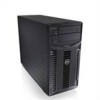Dell PowerEdge T410 Hardware Owner's Manual - Page 194
Serial Advanced Technology Attachment. A standard interface between the, RAID 10 - motherboard
 |
View all Dell PowerEdge T410 manuals
Add to My Manuals
Save this manual to your list of manuals |
Page 194 highlights
peripheral - An internal or external device, such as a diskette drive or keyboard, connected to a system. pixel - A single point on a video display. Pixels are arranged in rows and columns to create an image. A video resolution, such as 640 x 480, is expressed as the number of pixels across by the number of pixels up and down. POST - Power-on self-test. Before the operating system loads when you turn on your system, the POST tests various system components such as RAM and hard drives. processor - The primary computational chip inside the system that controls the interpretation and execution of arithmetic and logic functions. Software written for one processor must usually be revised to run on another processor. CPU is a synonym for processor. PXE - Preboot eXecution Environment. A way of booting a system via a LAN (without a hard drive or bootable diskette). RAC - Remote access controller. RAID - Redundant array of independent disks. A method of providing data redundancy. Some common implementations of RAID include RAID 0, RAID 1, RAID 5, RAID 10, and RAID 50. See also mirroring and striping. RAM - Random-access memory. The system's primary temporary storage area for program instructions and data. Any information stored in RAM is lost when you turn off your system. R-DIMM - A registered DDR3 memory module. readme file - A text file, usually shipped with software or hardware, that contains information supplementing or updating the product's documentation. read-only file - A read-only file is one that you are prohibited from editing or deleting. ROM - Read-only memory. Your system contains some programs essential to its operation in ROM code. A ROM chip retains its contents even after you turn off your system. Examples of code in ROM include the program that initiates your system's boot routine and the POST. ROMB - RAID on motherboard. SAN - Storage Area Network. A network architecture that enables remote networkattached storage devices to appear to a server to be locally attached. SAS - Serial-attached SCSI. SATA - Serial Advanced Technology Attachment. A standard interface between the system board and storage devices. SCSI - Small computer system interface. An I/O bus interface with faster data 192 Glossary















